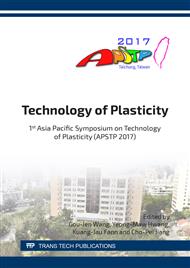p.193
p.199
p.205
p.211
p.217
p.223
p.230
p.236
p.244
Effect of Strain Path Change on Formability of TRIP Steels
Abstract:
The effect of strain path change on formability of TRIP590 and TRIP780 was investigated experimentally. Two-step uniaxial tension tests, which consist of the first loading in the rolling direction (RD) and the second loading in the directions varied from RD to transverse direction (TD) in every 15º, were conducted. The evolution of strain rates inside and outside the localized necking zone were inspected by using DIC measuring technique. When the angle between the two loading directions was increased from 0º to 90 º, the subsequent hardening behavior in second step was transited from cross-loading type to Bauschinger type. The total elongation was increased when the two loading directions are close to each other and then it was decreased with the increase of angle. When the angle further increased to 90 º, the total elongation is increased again. It is believed that both of the martensite transformation and Bauschinger type transient has a positive impact on the formability of TRIP steels.
Info:
Periodical:
Pages:
223-229
Citation:
Online since:
April 2018
Authors:
Keywords:
Price:
Сopyright:
© 2018 Trans Tech Publications Ltd. All Rights Reserved
Share:
Citation:


